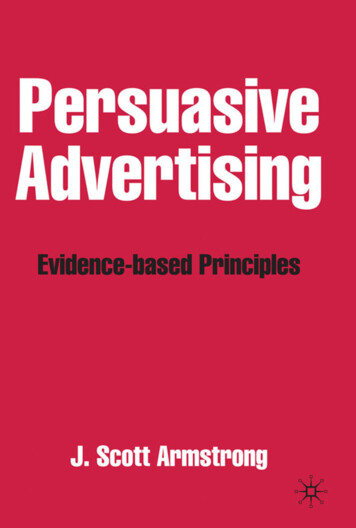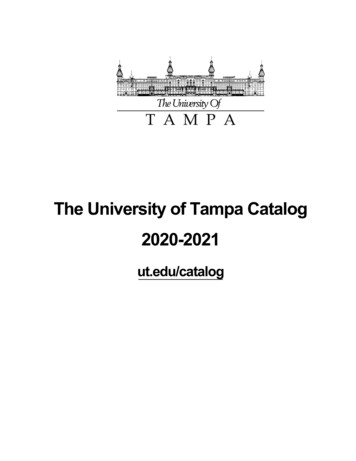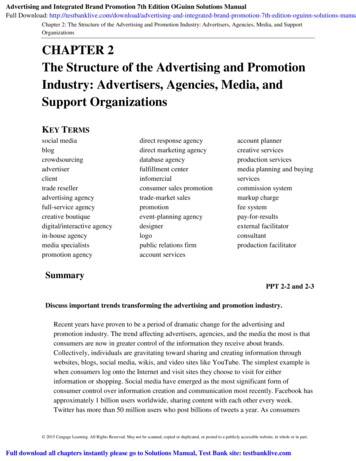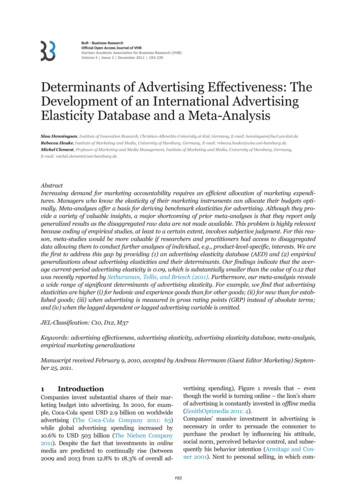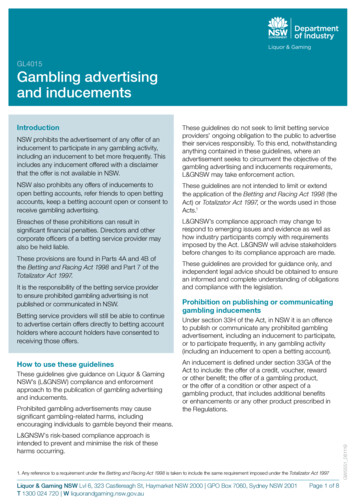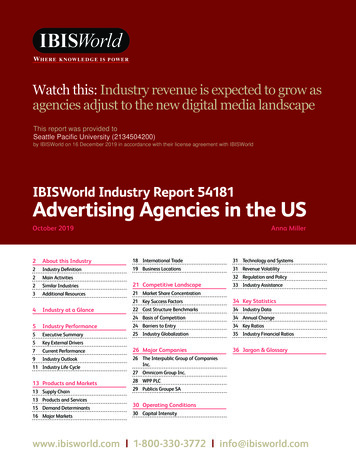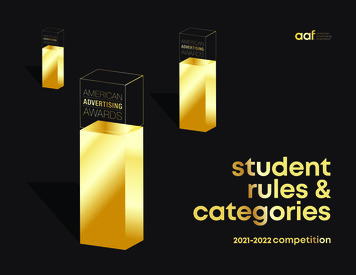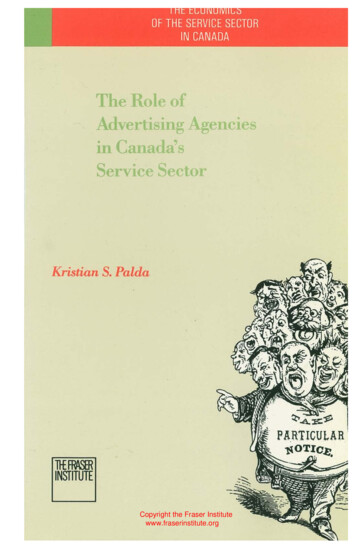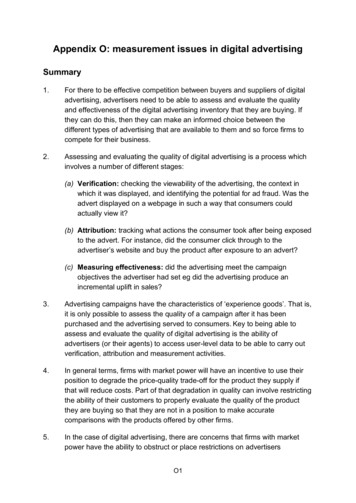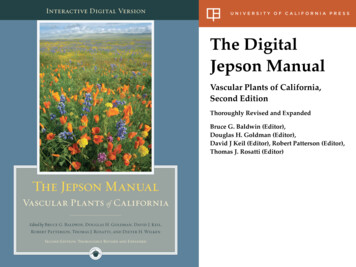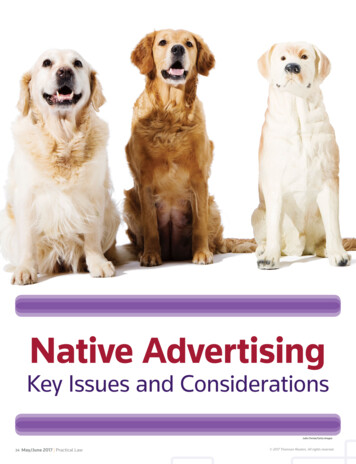
Transcription
Native AdvertisingKey Issues and ConsiderationsJulia Christe/Getty Images34May/June 2017 Practical Law 2017 Thomson Reuters. All rights reserved.
DAVID ERVINPARTNERCROWELL & MORING LLPDavid is a partner in the firm’sWashington, DC office and amember of the Advertising &Product Risk Management andIntellectual Property groups. His practice focuses onthe relationship between advertising and intellectualproperty law, primarily for consumer brands makingsignificant investments in media and content creationand licensing. Specifically, David assists clients withmanaging and protecting their brands and intellectualproperty rights in connection with their advertising,media, sponsorship, licensing, sports marketing,e-commerce, loyalty program, and joint promotionactivities.Native advertising is an increasingly popular andrapidly evolving form of advertising that has thepotential to influence consumer behavior moreeffectively than traditional advertising. Companiesseeking to conduct a native advertising campaignmust understand the different types of nativeadvertisements and the legal issues involved. 2017 Thomson Reuters. All rights reserved.The Journal Transactions & Business May/June 2017 35
Native advertising is sponsored content that is intendedto match the visual design of a hosting publicationor website and to behave just like editorial content.Native advertising blurs the line between content andadvertising.For most companies, the goal is for a native advertisement toblend seamlessly with the medium on which it is displayed, sothat consumers digest the information without losing interestbecause the content is an advertisement. The perfect nativeadvertisement is one that consumers look at and are drawn tofor its content, even though they ultimately recognize that it isan advertisement.A native advertisement could be a blurb or page in a magazine,a YouTube video, a recommended article on a blog, or anin-stream link on a social media platform. The medium isnot the primary focus. The form and function of the nativeadvertisement are the key elements.Native advertising is popular with advertisers, and the amountof resources being directed at it is expanding every day.However, native advertising can subject a company to consumerlitigation and government enforcement actions. Severalgovernment agencies have expressed concerns about this typeof advertising, and self-regulatory organizations are providingguidance to companies on best practices regarding a host oflegal issues.This article provides an overview of native advertising. Inparticular, it discusses: The various types of native advertisements. Key trends in native advertising. The primary risks and rewards of native advertising. The legal and self-regulatory framework surrounding nativeadvertising. Best practices for protecting a company against advertisingliability. Search Advertising: Overview for a general overview of advertisingrules and regulations in the US, including legal issues to considerwhen planning an advertising campaign.TYPES OF NATIVE ADVERTISEMENTSThe term native advertisement covers a variety of advertisementsthat the Interactive Advertising Bureau (IAB) defines in its NativeAdvertising Playbook, issued in 2013 (available at iab.com).According to the IAB, native advertisements include: In-feed units. These advertisements appear in the middle ofeditorial or social media content on sites such as Facebook orBuzzFeed. Paid search units. These advertisements are search results,typically highlighted in a different color, that appear at thetop of the page before other search results on sites such asGoogle, Bing, or Yahoo!. Recommendation widgets. These advertisements are poststhat appear on the side of a page or at the bottom of an36May/June 2017 Practical Lawarticle and recommend additional content for the reader onsites such as Huffington Post or ESPN. Promoted listings. These advertisements are product listingsthat might appear on shopping websites or search pages thatare promoted by sellers such as Amazon.com or Google. In-ad with native element units. These advertisementscontain content that is meant to look like the editorial contentaround it. Custom/can’t be contained. These advertisements fall into acatch-all category for other native content.TRENDS IN NATIVE ADVERTISINGSponsored content has existed since the earliest days ofbroadcast radio and television, when advertisers sponsoredpopular programs and directly influenced their content. Nativeadvertising today is more fluid and subtle, taking advantageof the content opportunities created by digital, mobile, andvideo technology. Recent trends in native advertising center onhow advertisers create content, as well as how mobile devicesand applications increase both the efficiency of advertisingcampaigns and the complexity of issues advertisers mustaddress. Key trends include: Rising investment in native advertising. Nativeadvertisements are becoming more important to brands,and companies are devoting increasing amounts of money tocreating native advertising campaigns. Annual spending fornative advertising in the US is expected to reach 21 billionin 2018 (BI Intelligence, Spending on Native Advertising IsSoaring as Marketers and Digital Media Publishers Realize theBenefits, Business Insider (May 20, 2015)). Advertisers andadvertising agencies also increasingly want to spend theiradvertising budget on social media. Increasing use of user-generated content. Brands areengaging more with their customers. The dialogue isincreasingly interactive, and customers are actively generatingoriginal content that focuses on the brand. Companies arelaunching advertising campaigns that thrive by inspiring usersto create their own content, including tweets and videos. Reliance on lifestyle bloggers. Companies are selling theirproducts by relying on bloggers and other social influencersto sell a way of life to consumers that includes those products. Creation of in-house sponsored content by publishers.Publishers have been creating sponsored content foradvertisers for several years. Most publishers generallyview native advertising as a way to make up for lost revenueresulting from flagging print publications, non-performingonline banner advertisements, and declines in moretraditional forms of digital advertising. Publishers initiallyused designated staffs of writers and editors to createsponsored content for advertisers. Increasingly, publishers arerelying on their existing editorial staffs to create sponsoredcontent in addition to editorial content. In January 2015,for example, Condé Nast launched its in-house sponsoredcontent group, 23 Stories by Condé Nast, which generatessponsored content for advertisers using the company’sexisting editorial and design staff (Steven Perlberg, Condé 2017 Thomson Reuters. All rights reserved.
Nast Unveils Branded Content Shop Powered by Editors, TheWall Street Journal (Jan. 26, 2015)). Facilitation by third parties. Startups are moving into thenative advertising space and are creating custom contentfor companies and their brands, leading to new dynamics ofcontent ownership and control. Growing dependence on mobile browsing and technology.Consumers are relying more on mobile devices and less onnewspapers, magazines, and even computers. Traditionalforms of advertisements are not very successful at transferringto on-the-go platforms. Native advertising is filling that space,with the help of technology advancements such as:zzsilent autoplay video;zzinfinite scrolling; andzzreal-time programmatic delivery platforms. Distribution through viral campaigns. With the success ofviral campaigns, the dynamic of advertising cycles has shifted.Now, even after companies stop paying for ad placements,many native advertisements live on through viral distributionbecause web and mobile users repost them to their ownsocial media pages and share them with friends.Native advertising can damagea brand’s integrity if consumersfeel they have been dupedinto believing that the nativeadvertisement they are readingor watching is editorial content,but later discover that it is brandsponsored content.RISKS AND REWARDS OF NATIVE ADVERTISINGNative advertising, when done right, can be more effectivethan traditional advertising. When done poorly, it can cost abrand credibility and lead to costly litigation and governmentenforcement.RISKSAdvertisers must consider a variety of risks when developing anative advertising campaign, including: Violating Section 5 of the Federal Trade Commission Act(FTC Act), which prohibits unfair methods of competition(15 U.S.C. § 45; for information on the FTC Act, search FTCAct Section 5: Overview).For example: According to an IPG Media Lab and Sharethrough studyconducted in 2013, Exploring the Effectiveness of NativeAds (available at ipglab.com), consumers look at nativeadvertisements 52% more frequently than banneradvertisements, and native advertisements lead to an 18%higher intent to purchase an item advertised than traditionalbanner advertisements. The UK Association of Online Publishers (AOP) released areport in 2015, The Power of Native, which found that:zz Facing regulatory enforcement actions, including under stateUnfair and Deceptive Acts and Practices (UDAP) laws. Defending against consumer class action and competitorfalse advertising litigation. Losing consumer trust.zzMost companies already face regulatory risks. Gaining andmaintaining consumer trust, however, becomes more importantwith native advertising. Native advertising can damage a brand’sintegrity if consumers feel they have been duped into believingthat the native advertisement they are reading or watching iseditorial content, but later discover that it is brand-sponsoredcontent. Additionally, readers might feel they can no longer trusta publisher’s reporting if the publisher does not clearly disclosewhen content is sponsored by advertisers. Relevancy and thequality of contact between the content and consumers have asignificant influence on the scope of these risks.REWARDSNative advertisements can be significantly more successful thantraditional forms of advertising at drawing consumers in andmaking them remember a brand. 2017 Thomson Reuters. All rights reserved.zznative advertisement drivers outrank traditionaladvertisements in key categories, including beinginformative, interesting, useful, and helpful. Traditionaladvertisements ranked about the same as nativeadvertisements on being eye-catching and higher onbeing clear/easy-to-understand and ordinary;59% of consumers surveyed found native advertisementsinteresting; and33% of consumers surveyed were more likely to trust nativeadvertising than traditional advertising.(Press Release, AOP, AOP Releases The Power of NativeResearch Report (Mar. 4, 2015).)LEGAL AND SELF-REGULATORY FRAMEWORKAs with traditional advertisements, there is no one legalframework that applies to, or government body that oversees,native advertisements. Many organizations are releasing bestpractices guidelines for advertisers to follow, and severalgovernment agencies are indicating their concerns throughadvisory opinions, guidelines, and enforcement actions.Currently, however, only the Federal Trade Commission (FTC) hasreleased rules or guidelines specific to native advertisements.The Journal Transactions & Business May/June 2017 37
The parameters of what is allowed in the native advertisingspace are still largely undefined. Absent clear guidelines aboutwhat companies can and cannot do, native advertisers mustconsider a range of legal issues, including: First Amendment protection. Right of publicity laws. Guidance provided by the FTC. The potential for consumer litigation regarding false ormisleading advertising. Actions by government agencies and self-regulatoryorganizations challenging deceptive native advertisements. The effectiveness of disclosures to prevent deception.FIRST AMENDMENT PROTECTIONThe First Amendment is relevant to all native advertising issuesand may have significant ramifications for companies. In thetraditional advertising context, if an advertiser includes anexpress offer of sale, the content will be classified as commercialspeech. Commercial speech is afforded less First Amendmentprotection than non-commercial speech and is subject to moregovernment regulation. Search Advertising: Overview for more on restrictions oncommercial speech.When advertisers create and distribute content that does notinclude an express offer of sale, however, it is unclear how courtsand regulators will treat that content. Native advertising has beenpresumed to fit primarily into the commercial speech category,but courts presented with the issue might reach a differentconclusion regarding the nature of native advertising, especiallywhen no branding or product offers are included. If companiescan create and publish content that qualifies for First Amendmentprotection, the dynamics of advertisements could change.Many companies, for instance, are creating advertisingcampaigns that have a message of social change. Upworthy, aweb publisher similar to BuzzFeed that aggregates content fromaround the web, partnered with Unilever in 2014 to promoteProject Sunlight, a “long-term initiative ‘to motivate people tolive sustainably by inspiring them to create a brighter future forchildren.’” The fact that Project Sunlight encourages consumersto purchase Unilever products was implicit in the content, butit was not the obvious, overarching theme of the campaign.(Michael Sebastian, Upworthy to Run Native Ads That Try toMake You Feel Good, Advertising Age (Apr. 1, 2014).)This partnership was part of Upworthy’s advertising modelcalled “Upworthy Collaborations,” the stated goal of whichwas to partner with companies and nonprofit organizations togenerate native advertising content that has a social message.Upworthy reported that these campaigns generated 10 millionin revenue in 2014, and that Upworthy’s advertising contentfrequently outperforms editorial content in terms of the numberof hits from readers. (Michelle Castillo, Emotional and Effective,Upworthy’s Native Ads Have Brought in More Than 10 Million forthe Site, Adweek (Feb. 20, 2015); Michael Sebastian, Upworthy,Joining a Refrain, Says Paid Posts Get More Views Than Editorial,Advertising Age (July 10, 2014).)Whether this money-generating content is commercial speechor editorial content deserving First Amendment protection isnot yet settled. For now at least, this content is subject to closergovernment oversight and receives less First Amendmentprotection. It remains to be seen whether this will change asnative advertising evolves in the coming years.RIGHT OF PUBLICITYAdvertisers that are active in the native advertising space mightencounter issues involving the right of publicity. If a companyproduces a native advertisement that uses the name or image ofa well-known person or celebrity, and the speech is consideredNative advertising has been presumed to fitprimarily into the commercial speech category,but courts presented with the issue might reacha different conclusion regarding the nature ofnative advertising, especially when no brandingor product offers are included.38May/June 2017 Practical Law 2017 Thomson Reuters. All rights reserved.
commercial in nature, the company must obtain authorizationfor using it and typically pays that person a license fee for suchuse. If the company does not take these steps, it runs the strongrisk of being sued. Search Right of Publicity: Overview for more on the right of publicity,including the scope, enforceability, and transferability of the right,remedies for violations of the right, and principal exemptions anddefenses to right of publicity claims.For example, two grocery chains, Jewel Food Storesand Dominick’s Finer Foods, placed advertisements in acommemorative issue of Sports Illustrated honoring MichaelJordan’s induction into the Basketball Hall of Fame in 2009.Jewel’s full page advertisement “salute[d] #23 on his manyaccomplishments” and “honor[ed] a fellow Chicagoan whowas ‘just around the corner’ for so many years,” playing off ofthe grocery chain’s slogan that it was “just around the corner.”Dominick’s touted Jordan as “a cut above” and featured acoupon for steak.Jordan filed lawsuits against both grocery chains for violationof his right of publicity. In August 2015, a jury awarded Jordan 8.9 million after a federal judge determined that Dominick’sviolated Jordan’s rights under the Illinois Right of Publicity Act(765 ILCS 1075/40) (Verdict and Settlement Summary, Jordan v.Dominick’s Finer Foods, 2015 WL 5656038 (N.D. Ill. Aug. 21,2015) (No. 10-00407)).However, because Jewel’s advertisement did not contain anexplicit offer of sale encouraging consumers to purchasesomething, a federal district court concluded that the contentdid not qualify as commercial speech. The US Court of Appealsfor the Seventh Circuit overturned that decision and remandedthe case to the district court. Several months after the juryverdict was entered against Dominick’s, Jewel settled its rightof publicity case with Jordan. (Jordan v. Jewel Food Stores, Inc.,851 F. Supp. 2d 1102, 1112 (N.D. Ill. 2012), rev’d, 43 F.3d 509, 512(7th Cir. 2014); Jon Seidel, Michael Jordan Settles with Jewel,Dominick’s, Chicago Sun-Times (Nov. 22, 2015).)FTC GUIDANCEThe FTC has clearly stated that deception is unlawful no matterthe medium (FTC, .com Disclosures: How to Make EffectiveDisclosures in Digital Advertising (2013) (.com Disclosures Guide)(available at ftc.gov)). Search Advertising and Promotions in Social Media for more on the.com Disclosures Guide, including the requirement that disclosures beclear and conspicuous.In December 2013, the director of the FTC’s Bureau ofConsumer Protection indicated at the FTC’s workshop onnative advertising, “Blurred Lines,” that, particularly with nativeadvertising, there “could be [FTC] enforcement, based onexisting law and existing standards” (Transcript at 300, BlurredLines: Advertising or Content? – An FTC Workshop on NativeAdvertising (2013) (available at ftc.gov)). This statement suggeststhat, in the FTC’s view, the legal framework governing general 2017 Thomson Reuters. All rights reserved.advertising provides sufficient statutory and regulatory supportto regulate native advertising.In December 2015, the FTC published its long-anticipatedguidance, Native Advertising: A Guide for Businesses (NativeAdvertising Guide) and an Enforcement Policy Statement onDeceptively Formatted Advertisements (available at ftc.gov).While the FTC noticeably did not further define commercialspeech in the native advertising context, the Native AdvertisingGuide makes clear that: Transparency is the key concern. Some native advertisements are so commercial in nature thatadditional disclosures are not required. If disclosure is necessary to prevent deception, the disclosuremust be clear and prominent. Search FTC Releases Policy Statement Explaining Deceptive AdFormats for Native Advertisements for more on how consumerprotection principles apply to different advertising formats, includingnative advertisements.The Native Advertising Guide seeks to identify disclosurepractices that prevent deceptive use of native advertising,providing 17 examples, and makes clear that potential liabilityextends to “[e]veryone who participates directly or indirectlyin creating or presenting native ads.” Like all FTC guidance,however, complying with the Native Advertising Guide doesnot provide a safe harbor from liability under Section 5 of theFTC Act.THE POTENTIAL FOR CONSUMER LITIGATIONNative advertisements seek to engage with consumers in a waythat feels more like editorial content and less like a promotion.As a result, in some respects, native advertisements carry aheightened potential to be considered false and, in particular,misleading. The content might be false or misleading inthe usual sense, by making unsubstantiated or misleadingclaims about a product or offering. The content might also beconsidered misleading by virtue of its form, if consumers cannottell that what they are reading or watching is an advertisement.This standard is not new, but its importance is much greater inthe native advertising space.However, many native advertisements are effective preciselybecause they do not make product claims. The contentmight sell a lifestyle, with the hope that consumers will thinkthey can gain that lifestyle if they buy the product, but theadvertisement makes no specific claim or express reference tothe advertiser’s product or service. Without a product claim,native advertisements are not deceptive in the same way astraditional advertisements, so it can be difficult to demonstrateconsumer harm.Unlike with traditional advertisements, there probably willnot be much competitor-driven litigation regarding nativeadvertisements. Companies all have a similar incentive tooperate in this space, and competitor actions would only thwartthe growth of native advertisements. There might, however, belitigation by consumers claiming they were deceived by a nativeadvertisement.The Journal Transactions & Business May/June 2017 39
GOVERNMENT AND SELF-REGULATORY ENFORCEMENTVarious government agencies and self-regulatory organizationsenforce advertising standards, but none have asserted enoughnative advertising claims to draw clear lessons for futureadvertisements. Federal government agencies have clearlysignaled, however, that they will not hesitate to step in andchallenge deceptive advertisements.The FTC and the National Advertising Division (NAD) of theCouncil of Better Business Bureaus are the most active inthe native advertising space and the most likely to undertakeenforcement actions, provide guidance, and issue advisoryopinions. Still, there is limited precedent in terms of case lawand regulatory enforcement.Examples of content likely to draw regulatory attention include: Product endorsements or recommendations by “experts” whoare actually paid employees or contractors of the company. Seemingly unbiased reviews by ordinary customers that areactually written by employees of a public relations firm hiredby the company.FTC EnforcementIn March 2016, the FTC announced the settlement of anenforcement action against retailer Lord & Taylor, LLC, regardinga native advertising campaign and social media influenceractivities that promoted a new dress line. Citing its recentlypublished guidance, the FTC challenged a “seemingly objective”online magazine article that provided a favorable review of thedress line, but was actually a paid ad placement. Online fashioninfluencers also posted favorable images of the new dress lineon Instagram and failed to disclose they were compensated byLord & Taylor, a fact that gave rise to a separate deceptivenessclaim. (Press Release, FTC, Lord & Taylor Settles FTC Charges ItDeceived Consumers Through Paid Article in an Online FashionMagazine and Paid Instagram Posts by 50 “Fashion Influencers”(Mar. 15, 2016).)The FTC has also brought enforcement actions in recent yearsagainst companies engaged in deceptive consumer reviewpractices, including against companies that: Pay their employees or affiliates to post reviews as if theywere ordinary consumers (In re Reverb Commc’ns, Inc., 2010WL 3441879 (F.T.C. Aug. 26, 2010) (employees); In re LegacyLearning Sys., Inc., 151 F.T.C. 383 (2011) (affiliates)). Encourage their employees to post favorable reviews withoutdisclosing their employee or agency connection (In re SonyComput. Entm’t Am. LLC, 2015 WL 1573331 (F.T.C. Mar. 24,2015); In re Deutsch LA, Inc., 2015 WL 1573330 (F.T.C. Mar. 24,2015); Press Release, FTC, Game over: FTC ChallengesSony’s Claims for PlayStation Vita and Tweets by Deutsch LA(Nov. 25, 2014)). Pay experts to endorse a product without disclosingthose payments (In re ADT LLC, 2014 WL 2996162(F.T.C. June 18, 2014)).Settlements occasionally include substantial financial penalties,but usually the most significant negative impact of a settlement,for any company, is being subject to a 20-year consent order thatrequires legal compliance and FTC review of similar advertising.40May/June 2017 Practical LawFuture FTC enforcement actions might involve publishers. Itis worth noting that some of the FTC’s guidance in the NativeAdvertising Guide sets up a potential battle with publishers byrequiring that disclosures: Be placed on sponsored images and graphics. Survive republication. Include more than company logos and names alone.In response to these disclosure requirements, many leadingpublishers cite the First Amendment and flatly reject theserestrictions on native advertising, especially on content thattheir editorial staff produces. The first test case the FTC bringsagainst a publisher under the Native Advertising Guide will beone to watch closely.NAD EnforcementThe NAD is an enforcement arm of the advertising industry’sself-regulatory system. Several NAD decisions since 2013 showthat the NAD is skeptical of native advertisements that involveother deceptive elements, including a failure to: Disclose the relationship of the creator of the content to theadvertiser (American Media, Inc. (Shape Water Boosters),Case No. 5665 (Dec. 18, 2013)). Clearly label the content as sponsored content (Taboola, Inc.,Case No. 5708 (May 5, 2014)).The NAD also concluded in one case that, after a companystopped promoting native content, it did not need to monitorwhether that content, when recirculated, was identified as beingsponsored content (Press Release, Advertising Self-RegulatoryCouncil, Native Advertising Review: NAD Examines Qualcomm/Mashable Sponsored Series (Sept. 30, 2013)). The difficulty withdrawing clear standards from these cases, however, is that NADdecisions are not binding precedent.Most recently, the NAD offered direction on the placement ofdisclosures in native advertisements (Joyus, Inc., Case No. 5956(May 19, 2016)). Citing the Native Advertising Guide, the NADdetermined that express disclosures in video links were requiredto avoid misleading consumers, even when other audio andvisual cues made the connection clear.THE EFFECTIVENESS OF DISCLOSURESOne of the key unanswered questions regarding nativeadvertising is whether disclosures can cure nativeadvertisements of being considered deceptive or misleading,or whether some native advertisements are so inherentlydeceptive that no amount or type of disclosures can cure them.However, the FTC did recognize the opposite situation in itsNative Advertising Guide. The FTC stated that some nativeadvertisements are so inherently commercial in nature thatadditional disclosures may not be necessary.Native advertisers should be aware of various sources ofguidance on disclosures, including: Rules developed in the traditional advertising context. Previous guidance for broadcasters and search enginecompanies. FTC guidance on disclosures. 2017 Thomson Reuters. All rights reserved.
Traditional Advertising RulesThe rules and best practices developed over the years fortraditional advertising still apply to native advertising, butadvertisers need to pay even more attention to their disclosuresin the native advertising space, where context does matter.Because there is a lack of specific regulations for nativeadvertising, the risks can be mitigated but not eliminated. Thefirst step in reducing risk is applying the rules and regulationsthat are in place for more traditional forms of advertisements.Therefore, when creating native advertising disclosures,companies should: Use an understandable label. Use consistent language for disclosures. Present the disclosure clearly and conspicuously, including byuse of visual cues. Use brand logos. Place the disclosures close to the advertisement. Visually separate the advertisement from editorial content. Avoid interaction between the editorial content and theadvertisement. Avoid over-disclosing.In addition, the FTC also provided relevant guidance ondisclosures to search engine companies. The FTC advised searchengines in 2013 that when consumers view search results, they“should be able to easily distinguish a natural search resultfrom advertising that a search engine delivers.” The FTC cited astudy that found that 62% of the consumers surveyed could nottell, without additional disclosures, that the top advertisementsappearing in search results were paid advertisements.Even though one of the tactics the search engines used todifferentiate sponsored results from other results was to usedifferent background shading, many consumers could not tellthe difference. The FTC counseled search engines to considerbest practices, including: Labeling the advertising results as “sponsored” or “ad.” Shading any advertising result with a different background color. Segregating any advertising from the natural results.(Letter from Mary K. Engle, Associate Director, Division ofAdvertising Practices, Bureau of Consumer Protection, FTC(June 24, 2013) (Search Engine Letter), at 1, 2 nn.3-4 (availableat ftc.gov).)Some of these lessons apply to native advertisements.Language such as “sponsored,” “ad,” or “branded content”signals to readers that they are encountering a paidadvertisement.FTC Digital Disclosures GuidanceThe rules and best practicesdeveloped over the years fortraditional advertising still apply tonative advertising, but advertisersneed to pay even more attentionThe FTC provided relevant guidance on disclosures in the.com Disclosures Guide. When companies advertise indigital publications, the .com Disclosures Guide states thatthe “ultimate test is whether the information intended to bedisclosed is actually conveyed to consumers.” The FTC advisesadvertisers to “adopt the perspective of a reasonable consumer”and to recognize that consumers will not read every word on thepage or the screen. To provide a meaningful disclosure, the FTCadvises that adve
native advertising in the US is expected to reach 21 billion in 2018 (BI Intelligence, Spending on Native Advertising Is Soaring as Marketers and Digital Media Publishers Realize the Benefits, Business Insider (May 20, 2015)). Advertisers and advertising agencies also increasingly want to spend their advertising budget on social media.
